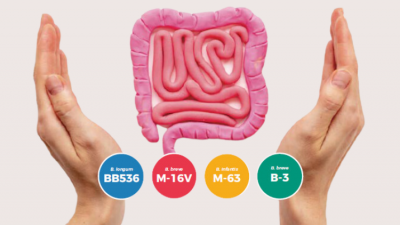Promotional Features
How an HRB probiotic strain can unlock opportunities for infant milk formulators
The infant milk formula market in China is the largest in the world and increasingly competitive.
China also has one of the toughest nutritional standards for infant formula. Stricter national regulations, which came into effect in February 2023, have required manufacturers to revise the minimum and maximum values of nutrients, mandate lactose content and ban fructose and sucrose. This has prompted a wave of heavy investment in reformulations across product lines.1
In addition to the new regulatory pressures, infant formula manufacturers in China are also facing a decline in births. Despite government intervention, the 2023 birth rate in China is 10.645 births per 1,000, a 2.36% decline from 2022, mirroring a similar annual decline for the three years prior.2 In parallel, China's population fell in 2022 for the first time in six decades, with the United Nations anticipating the country’s population to shrink by a further 109 million by 2050 and experts fearing a bleaker demographic and economic outlook than previously forecast.3
China’s shrinking population, coupled with the new ingredient rules, is adding further pressure on infant formula manufacturers to capture a share of an already competitive market. However, opportunities exist. The global market for baby food is stable and rising, with Euromonitor predicting growth to $81.9 billion by 2026 at a five-year compound annual growth rate (CAGR) of over 3% and within this market, infant milk formula is one of the fastest growing segments.4
A Unicef study examining early infant feeding decisions in China found ‘nutrition’ was perceived by women as the top benefit of formula feeding.5 As such, the Chinese market has seen a significant rise in premium infant milk formula, a segment that is forecast to account for approximately 53% of China's infant milk formula market by end of 2023.6 As consumers become more educated, coupled with China's growing urbanization and increasing disposable income, high quality products and scientific formulations have become an increasing focus for consumers. And the growth of premiumization rather than volume presents opportunities for manufacturers to innovate within this space.
Indeed, in recent years there has been a growing awareness of the importance of nutrition, in particular in developing and maintaining healthy gut microbiota in infants and children. Parents today focus on offering a nutritious and diversified diet to their babies, choosing infant formula and foods containing functional ingredients, such as probiotics, to promote healthy infant development from birth through to early years of childhood.
This is opening up markets for infant formula manufacturers to diversify product lines and increase market share by targeting other segments, such as pregnant women, toddlers and older children.7
But which probiotics are most effective as ingredients in value-added infant formula and best suited to contributing to the healthiest start in life? How can infant milk formula manufacturers tap new market opportunities and stay ahead of the competition?
Human-residential bifidobacteria (HRB)
Bifidobacteria belong to a group of probiotics and are the predominant bacteria residing in the gut of breastfed infants. Certain species are recognised as Human-Residential Bifidobacteria (HRB) and can have an effect on human health.
B. breve, B. longum, B. bifidum and B. longum are the most frequently observed HRB species in human infants, transmitted from mother to baby (infant-type HRB), and are the only bifidobacterial species that predominantly colonize the human infant gut. HRB strains have compatibility with human breast milk and can promote synergy between probiotics and prebiotic additions in infant formula.
The distribution of bifidobacterial species changes with host age and age-related dietary habits.8 In particular, B. longum species was found to be an exceptional HRB that resides in the human gut throughout the infant’s life. Even when the infant transitions to solid food and grows into adolescence, B. longum continues to colonize the gut and this has been shown to confer particular benefits that other HRB strains do not. This gives B. longum a competitive advantage as a probiotic ingredient in infant milk formula.
Benefits of B. longum BB536 in early life
Bifidobacterium longum subsp. longum BB536 was first isolated from a healthy infant gut in 1969 and is one of the most well-established, clinically effective probiotic strains. It has been shown to act in harmony with the gut microbiota to drive a fine-tuned intestinal and immune balance and can promote healthy gastrointestinal conditions, maintenance of intestinal microflora balance, regulation of immune response, anti-allergy, and protection against microbial infections.
For over 50 years, Morinaga Milk has amassed more than 230 scientific studies into B. longum BB536. With its strong scientific backing, and a raft of clinical studies on a diverse range of the population – from pregnant women to infants, toddlers, and older children – this probiotic strain can help manufacturers develop a value-added infant formula.
One study has compared the effects on the intestinal microbiota of administering a single strain of B. breve M-16V with a mixture of three strains composed of B. breve M-16V, B. infantis M-63 and B.longum BB536, and investigated the transition of each strain in low-birth-weight infants.9 The proportion of infants with bifidobacteria-predominant microbiota was significantly higher in the three-species group than in the control group at weeks 1 and 6 and during the test period.
Another randomized, double-blind control trial investigated the effects of BB536 supplementation on intestinal microbiota composition and the immune response in 300 healthy new-born infants.10 Of the 264 infants who completed the trial, the amount of bifidobacteria and the bifidobacteria/Enterobacteriaceae ratio (B/E) was significantly higher in stool samples in the BB536 supplementation group at months 2 and 4. The number of IFN-γ secretion cells and the ratio of IFN-γ/IL-4 secretion cells increased in the BB536 supplementation group at 7 months.
Moreover, the higher value of B/E in the early stages appeared to be related to the increased Th1 response. The study concluded that B. longum BB536 has positive effects on establishing a healthy intestinal microbiota early in life, and it also plays an important role in improving the Th1 immune response.
In addition, B. longum BB536 has also been shown to be effective in reducing allergy symptoms in infants in combination with B. breve M-16V when administered to pre- and postnatal mothers. In a 2014 study, a combination of B. breve M-16V and B. longum BB536 was given to 130 prenatal mothers one month prior to delivery and postnatally to their infants for six months. The risk of developing eczema / atopic dermatitis (AD) during the first 18 months of life was shown to be significantly reduced in infants in the probiotic group, suggesting that prenatal and postnatal supplementation of bifidobacteria that includes B. longum BB536 is effective in primary prevention of allergic diseases.11
B. longum BB536 supplementation for children
The diverse effects of BB536 across a range of populations and demographics is one of its benefits, thanks to its adaptive capacity in the gut environment throughout the human lifespan. This is an advantage over other bifidobacterial species whose residential features may be impacted by changes to diet and environment from birth into adolescence.
The effects of BB536 to promote healthy gastrointestinal conditions were evidenced in a multicentre, randomized, double-blind, placebo-controlled, crossover trial involving 48 children with IBS and 25 with Functional Dyspepsia (FD), where the proportion of IBS children achieving an improvement in Quality of Life was significantly higher after probiotics than after placebo (48% vs. 17%, P=0.001).12 Another placebo-controlled, double-blind and randomized study evidenced that a bifidobacteria mixture containing BB536 significantly improved allergic rhinitis symptoms and Quality of Life in children with pollen-induced AR and intermittent asthma.13
Evidence also suggests that BB536 can confer health benefits in growing up milk for children, with potential for protective effects in high-prone seasons for upper respiratory illnesses.14 In a 10-month randomised, double-blind, parallel and placebo-controlled study the effects of BB536 on diarrhoea and/or upper respiratory illnesses were evaluated in 520 healthy Malaysian children aged 2-6 years old.
The study found that oral consumption of BB536 for 10-months had beneficial effects against respiratory illnesses and was more prevalent in protecting children against number of occurrences for respiratory illnesses, and duration of fever, sore throat, runny nose, and cough, while the placebo did not exhibit such benefits. In addition, BB536 also modulated gut microbiota and contributed to maintaining the abundance of beneficial microorganism such as Faecalibacterium, which may have exerted immuno-modulatory effects.
Formulation innovations with BB536
As a multifunctional HRB probiotic, BB536 has a proven track record of safety and clinical efficacy in improving gastrointestinal, immunological, allergy and infectious conditions, and protecting against microbial infections. As well as its inclusion to supplement infant formula, BB536 is used in functional food ingredient in various products such as milk-based drink, yogurt, yoghurt drinks and non-fermented milks.
Despite the challenges of today, there is potential for niche segments to adapt to a changing environment and thrive. Thanks to Morinaga’s wide-ranging accumulation of evidence into early life nutrition and probiotic supplementation, combined with BB536’s long history of Safe Use in Food Products, manufacturers can be confident they are choosing a clinically-safe and effective supplementation.
To find out more visit Morinaga Milk Probiotics Center.
References
1. Reuters. Analysis: New rules set to shake up China's shrinking infant formula market. (June 2023).
2. China Birth Rate 1950-2023.
3. Reuters. China's first population drop in six decades sounds alarm on demographic crisis. (January 2023).
4. Dairy Products and Alternatives: Euromonitor from trade sources/national statistics. Baby Food Market Size (World). Euromonitor Passport. (Extracted April 2023).
5. A Unicef Commissioned Report. A Multi-country Study of Early Infant Feeding Decisions - China Report.
6. China Staples. IMF – Structural Opportunities in Stable Market. Research Report from Haitong International Securities Group Limited. (28 April 2022).
7. Euromonitor International. Global Infant Formula Industry: Focus on Asian Markets.
8. Sakurai, T.; Odamaki, T.; Xiao, J-z.; (2019). Production of Indole-3-Lactic Acid by Bifidobacterium Strains Isolated from Human Infants. Microorganisms. Volume 7, Issue 9: 340.
9. Ishizeki, S.; Sugita, M.; Takata, M; et al. (2013). Effect of administration of bifidobacteria on intestinal microbiota in low-birth-weight infants and transition of administered bifidobacteria: a comparison between one-species and three-species administration. Anaerobe. Volume 23: 38-44.
10. Wu, B. B.; Yang, Y.; Xu, X.; et al. (2016). Effects of Bifidobacterium supplementation on intestinal microbiota composition and the immune response in healthy infants. World journal of Pediatrics. Volume 12, Issue 2, 177–182.
11. Enomoto, T.; Sowa, M.; Nishimori, K.; et al. (2014). Effects of Bifidobacterial Supplementation to Pregnant Women and Infants in the Prevention of Allergy Development in Infants and on Fecal Microbiota. Allergology International. Volume 63, Issue 4: 575-585.
12. Giannetti, E.; Maglione, M.; Alessandrella, A.; et al. (2017). A Mixture of 3 Bifidobacteria Decreases Abdominal Pain and Improves the Quality of Life in Children with Irritable Bowel Syndrome: A Multicenter, Randomized, Double-Blind, Placebo-Controlled, Crossover Trial. J Clin Gastroenterol. Volume 51, Issue 1.
13. Miraglia Del Giudice, M.; Indolfi, C.; Capasso, M.; et al. (2017). Bifidobacterium mixture (B longum BB536, B infantis M-63, B breve M-16V) treatment in children with seasonal allergic rhinitis and intermittent asthma. Ital J Pediatr. Volume 43, Issue 1: 25.
14. Lau, A. S.; Yanagisawa, N.; Hor, YY.; et al. (2018). Bifidobacterium longum BB536 alleviated upper respiratory illnesses and modulated gut microbiota profiles in Malaysian pre-school children. Benef Microbes. Volume 9, Issue 1: 61-70.










